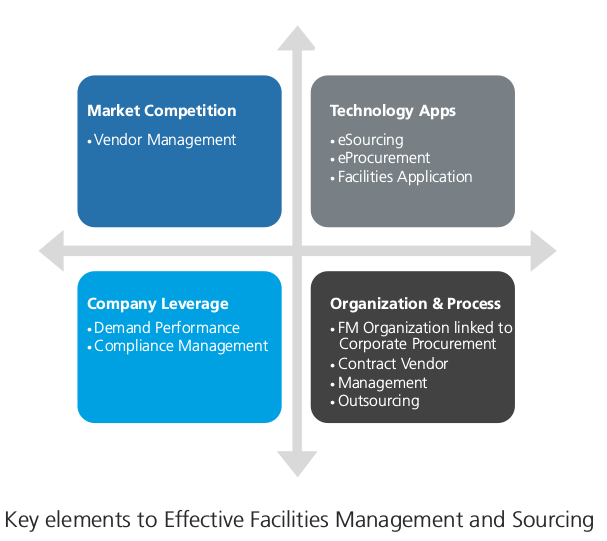Highlights
Facilities and related support services represent a significant cost in most companies. Optimization of these services can make a huge impact on a company's financial results.
The adoption of firm-wide standards and processes, combined with strategic sourcing as well as the use of outsourcing vendors for non-strategic facilities services, is a key element in the pursuit of cost effectiveness and process optimization. The trends include:
- Higher quality service delivery at lower cost
- Increased application of automation technology
- Outsourcing benefits
- Related gains in skills and domain expertise
Background
Facilities management and support services form a sizeable portion of spend in most companies. It is imperative to reduce cost and consistently improve quality of services. Therefore, optimization of these services can have a huge impact on a company's performance.
Facility management represents planning, control and operational management of facilities related to services that support client needs, and the optimal acquisition of cost-effective external service delivery.
Operational management of facilities comprises various elements :
Figure 1: The components of Facility Management
Facilities Management
- Facilities Services
- Space Management
- Infrastructure (Information and Communications Technology)
- Facilities & Properties Management
- Sourcing & Vendor Management
Outsourcing Facility Management
Facility Management Outsourcing is an important strategic decision for the following reasons:
- Management needs to focus on the core businesses and save time and effort on support activities
- Considerations regarding building in-house capability or outsourcing of services (“make vs. buy” decisions)
- Leverage established capabilities in facilities and performance management by outsourcing to companies that specialize in these domains
In order to identify important value-creation efforts, typically the following specific support services are addressed:
- Cleaning services (customer-facing, office, industrial, parking, access space)
- Indoor climate functions (cooling, ventilation, heating)
- Facilities or property management functions (invoicing, accounts, reporting)
- Building and construction management
- Investment properties and tenant management
Current Facilities Management Practices
The Growing Importance of Performance Benchmarking
Benchmarking enables firms to identify opportunities for improvement, learn about the impact of volume variances, monitor what best-of-breed companies achieve, and understand how targets are set.
An effective benchmarking program uncovers issues that need to be acted upon and provides the management and staff guidance for execution of programs and implementation of change.
Benchmarking needs to be done periodically and at high levels of sophistication. It can be a costly and lengthy process and needs to be well-structured to include clear objectives, scope, and a statement of anticipated benefits. Benchmarking can be accomplished through:
- Customer surveys to determine perceptions of quality and operational performance
- Benchmarking an organization's operations by calculating staff costs, cost/square foot, breakdowns of activity costs, risk incidents/hours worked etc., and identifying internal best practices
- Benchmarking suppliers' costs, operations, and performance
While benchmarking of costs and service levels has become easier, facilities managers still rarely use benchmarks. Managers typically believe that their real estate sites and facilities are not comparable with external benchmarks. They also have difficulty consolidating large amounts of internal data on building and property usage. This has the following benefits:
- Sets performance measures for property and facilities managers
- Forecasts demand for workplace environments, refurbishments, and service levels
- Helps determine whether to outsource, to whom to outsource, and set contractual targets
Performance benchmarking becomes a critical parameter for success in any outsourcing relationship. Unfortunately, benchmarking is rarely given the attention it deserves, resulting in inappropriate expectations, unclear objectives, and disappointing outcomes. This can be avoided by:
- Establishing performance measurements up front
- Operating on clear baseline data, specified improvement requirements, and standards
- Ensuring that all parties adhere to an outsourcing agreement, understand the expectations and responsibilities, operate under a joint governance structure, and share responsibilities
Adopting Industry Standards
Using industry standards is an important decision for operating within a self-regulating compliance environment, achieving optimal cost, and operational efficiency. Several industry associations actively monitor legislative actions, industry codes, and standards. They periodically publish guidelines around standards and measurements, allowing the exchange of professional expertise, relationship-building, sharing knowledge of industrial information, and industry trends, etc.
Some renowned industry associations are:
Building Owners and Managers Association International (BOMA)
BOMA represents building owners, developers, leasing professionals, corporate facility managers, asset managers, and suppliers of products and services needed to operate commercial properties. It is a global source for industry benchmarks.
BOMA monitors legislative actions and other issues relevant to the field of facilities management, including utilities deregulation efforts, property laws and environmental concerns. It also distributes several publications.
BOMA's 2009 Experience Exchange Report (EER) presents statistics on the commercial real estate landscape in US cities, including detailed information covering public and private sector real estate, downtown and suburban buildings, and size ranges. It also provides analysis on the economic situation and its impact on real estate. This type of information facilitates comparison of building operations and evaluating a company's operating expenses. It also enables key corporate level activities, such as development of operating strategies, compiling budgets, underwriting, analyzing acquisition opportunities, and communication with investors and owners.
Most facilities managers of large corporations with already established best-in-class operations tend to confirm the use of BOMA's reporting data for benchmarking purposes. They also recommend finding and applying the most cost-effective facilities maintenance standards across all properties and locations to create internal capabilities that can compete with external service providers.
International City/County Management Association (ICMA)
ICMA is a professional and educational organization for administrators in local government. It publishes the annual Comparative Performance Measurement Data Report.
International Facilities Management Association (IFMA)
IFMA is the largest and most widely recognized professional association for facilities management. It publishes the annual Operations and Maintenance Benchmarks guide. One of the IFMA's four main goals is to lead the progress of the facilities management profession by identifying trends, needs, and outcomes for the future. To accomplish this, IFMA periodically conducts annual forecasting workshops with industry participation.
Future costs are broken down into:
- One-time costs, such as replacement costs, recorded at the end of the year in which they occur
- Recurring costs, representing annual expenses incurred at the end of each year
To determine the present value of future one-time and recurring costs, the following formulas are applied:Present value of future one-time costs: Recent value of future recurring costs:
PV = A(t) x 1/(1+d)t
PV = A(0) x [ (1+d)t - 1]/[d x (1 + d)t]
The Evolution of Procurement and Sourcing
Facilities management sourcing followed the general evolution of sourcing and procurement with the more recent adoption of firm-wide processes, sourcing technology, and methodologies taking place in most large organizations. Facilities services were typically part of the facilities or real estate group and external services were generally procured through local, or at best, regional vendors.
Corporate procurement was gradually able to apply its expertise in strategic sourcing, vendor negotiation, and contracting. This was done by utilizing e-sourcing and e-procurement applications for improved performance and moving to shared services models to provide optimal service delivery to business units.
Aggressive sourcing, particularly when combined with e-sourcing, reverse auction tools, and effective vendor negotiations, has typically been known to achieve annual savings in the range of 10 per cent-15 per cent, and more, for categories such as janitorial services, HVAC, building repair/maintenance, securities services, and property management.
See Figure 2 for the key elements influencing FM sourcing and the procurement process.

Outsourcing in Facilities Management
While specific facilities services have been strategically sourced since a long time, FM as a function has been considered for outsourcing only in the last few years in view of the profession becoming more mature and complex, and third-party property management companies taking on broader roles. Organizations increasingly recognize the difficulty and cost associated with retaining all of the necessary expertise and technical resources. More companies are turning to single-source providers to manage aspects of their facilities.
Decisions regarding the outsourcing of non-core functions are based on some of the following criteria:
- Can we reduce costs and improve services beyond our own capabilities?
- Can there be a single point of responsibility for essential support services while maintaining required control?
- Are there case examples and documented experiences to ensure that outsourcing is the best mode of service delivery?
The selected facilities service providers need to demonstrate that their performance matches industry standards as well as the metrics of peers and competitors. One of the challenges for outsourcing providers is that once buyer companies experience initial cost benefits through outsourcing, they continue looking for cost savings. They use the new lower cost base as the standard to achieve further reductions, not considering that business costs increase every year.
Operating in an Outsourced Environment
In-house facilities management staff will get directly affected by corporate cost reduction initiatives when transitioned ('rebadged’) to an outsourced vendor. The in-house staff will likely receive lower total compensation because FM has traditionally been a low- margin business. This benefits the FM provider initially since transitioned employees have an intimate knowledge of the buyer's culture, mission, or operations environment. Vendors generally agree to retain wage parity for transitioned workers for no longer than six months or a year. Eventually the compensation is reduced to conform to the vendor's own salary structure. Job security is not guaranteed beyond an introductory time period, though employees might find security in the stability of the contract. The vendor, however, wants to be able to let go of employees as quickly as possible so that an outsourced employee's career with the vendor is somewhat reliant on the contract developed for the buyer. If a contract is terminated without renewal, the employee is not guaranteed a new position with another contract.
Balancing Outsourcing and “In-sourcing”
Outsourcing tends to follow cyclical patterns, balancing cost and quality. Companies initially outsource to reduce costs, and then return functions back in-house in order to regain lost service quality.
The benefits of outsourcing include:
- Transfer of personnel responsibilities: This important benefit means that once an employee gets sick, the service provider will find a replacement at no added cost. This eliminates the need for the buyer to find a replacement and pay for extra work.
- Changing employees that do not perform at agreed upon standards of performance: This is easier to demand from an outsourcing provider.
- Possibility of greater learning: From the facility management employee's perspective, large outsourcing companies tend to provide the possibility of greater learning and career progress for functional facility management specialists when in- house organizations don't offer similar opportunities.
The most common down-sides of outsourcing are the normal service quality problems, lost in-house expertise and smaller, de-motivated service staff count. Implications from outsourcing often do not become apparent until the second or third cycle of an outsourcing program, when companies, after several years of outsourcing, realize that they have lost the industry knowledge and ability to competently specify and manage outsourced services.
Trends in Facilities Management
In the face of mounting cost reduction pressures, facilities managers are finding ways to increase efficiencies through:
- Higher-quality maintenance at lower cost: Doing more with less by accomplishing objectives with reduced capital expenditure, and less time and people/square foot, they are constantly trying to improve efficiency through better planning and scheduling or including time-saving products for maintenance tasks.
- Applying automation technology: Facilities managers are increasing their reliance on hand-held devices to minimize paperwork and boost the accuracy of data collection, the integration of facilities management functions, and increasing their focus on integrating facility/ maintenance/ building control systems.
- Outsourcing and the derived benefits of improved personnel training: Facilities managers have access to deeper domain expertise and technology and the ability to better track equipment performance.
- Concentrating on core competencies, acquiring expertise: Facilities managers using outside contractors are ultimately able to cut overall facilities management expenses and investments.
- New approaches forced upon them by tightened budgets: Facilities managers are forced to squeeze the most functionality out of existing space by creating customized cost-effective and productivity-enhancing facilities to suit the needs of the organization. This is accomplished by conserving energy through energy audits and related improvement programs, employing temporary staff to assist in-house staff with unplanned work, and ensuring facilities run at full capacity all the time.
Future of Facility management
Technology will play an integral role in facility management
Applications in e-sourcing, e-procurement, business planning, and management will help achieve improvements in process effectiveness, monitoring of costs and benefits among several options.
Value creation will gain importance
As facility managers are required to expand their roles and accountabilities, they will gain expertise in project and people management, as well as energy management and productivity measurement to create tangible value for the organization.
Outsourcing partnerships will become the norm
As facility managers include corporate requirements into their operations, they will need to integrate increasing financial considerations to minimize capital risk and outsource non-critical business assets and services.
Theme: Procurement



